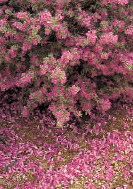
![]() chapter THREE
chapter THREE ![]()
Success with Desert Plants
Trees provide permanent structure to a design, establish the scale of the landscape, give visual proportion to open space, and define the “ceiling” of the space. Several large trees can provide a landscape’s framework, with smaller trees, shrubs, vines and other plants playing supporting roles.
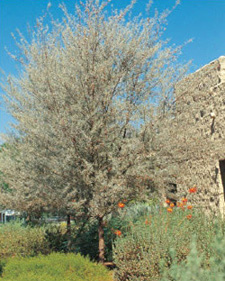
Acacia aneura, mulga.
Acacia species
Acacia
Acacias are native to regions all around the globe. With almost 1,000 species, a wide variety of forms, textures and colors are available, including both evergreen and deciduous plants. Acacias are tolerant of heat and are generally low to moderate water users. Provide trees with deep, infrequent irrigations to help establish root systems. Flowers are individually tiny but are clustered into puffballs or long drooping flowerheads called catkins.
Acacia aneura
mulga
Evergreen and thornless, mulga grows slowly to 20 feet high and 15 to 20 feet wide. Small, narrow, silvery gray leaves are leathery, similar to those of an olive tree, and are dense along the branches. Makes a fine windbreak and screen. Yellow catkins, the flowers, are heaviest during late spring into summer. Native to Australia.
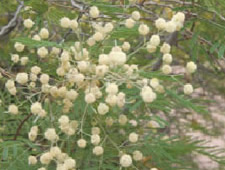
Acacia berlandieri, guajillo.
Acacia berlandieri
guajillo
Like many native American acacias, light green leaves are delicate and almost fernlike. Trees grow at a moderate rate from 10 to 15 feet high and 12 feet wide. Fragrant, cream-colored, puffball flowers bloom in tune with spring weather. Plant in well-drained soil. Smallish thorns are usually not a serious hazard. Gradually prune lower branches to develop small tree form. Native to southern Texas and Mexico.
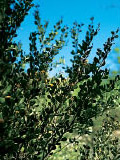
Acacia craspedocarpa, leatherleaf acacia.
Acacia craspedocarpa
leatherleaf acacia
Grows slowly from 10 to 15 feet high and 8 feet wide with a rounded crown. Evergreen with rounded, upright gray-green leaves. Yellow puffball flowers bloom spring to summer. Prune into a tree or leave shrubby as an alternative to oleander, effective as a screen. Native to Australia.
Acacia farnesiana
sweet acacia

(A. smallii, A. minuta). This is a medium, open, multi-trunk tree with vaselike form, fernlike leaves, small thorns, and fragrant flowers. Deciduous to semi-deciduous, grows at a moderate rate from 20 to 25 feet high and as wide. Yellow puffball flowers are profuse in spring and produce a wonderful sweet fragrance. Avoid heavy pruning as it leads to problematic suckers. Native to Mexico.
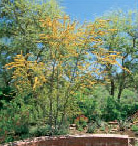
Acacia rigidula, blackbrush acacia.
Acacia rigidula
blackbrush acacia

A slow-growing small tree or large shrub reaches 15 feet high and as wide. Tolerates heat and drought, but will also accept moist conditions, such as near lawns. The smooth, gray bark contrasts nicely against glossy green leaves that are cold deciduous. Long catkins of cream-colored flowers bloom in spring. Some plants have thorns. Native to Chihuahuan Desert.
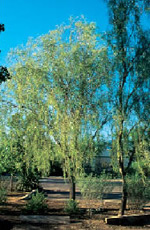
Acacia salicina, willow acacia.
Acacia salicina
willow acacia

A low-water and enduring alternative to weeping willow, which is short-lived in desert regions. Graceful, pendulous evergreen leaves on trees that grow rapidly from 20 to 40 feet high, spreading 10 to 20 feet wide. Creamy white puffball flowers bloom late summer into winter. Water deeply and well away from the trunk to avoid blow over during windstorms. Native to Australia.
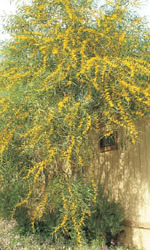
Acacia saligna, blue leaf wattle.
Acacia saligna
blue leaf wattle, weeping wattle
Rapid, aggressive, vertical growth with a dense canopy to 20 feet high with an equal spread. Evergreen leaves drape gracefully toward the ground. Yellow puffballs are mildly fragrant, appearing in spring. Native to Australia.
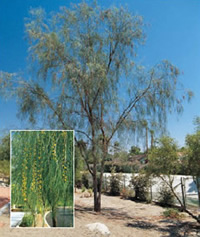
Acacia stenophylla, shoestring acacia.
Acacia stenophylla
shoestring acacia

Strong, vertical and graceful, rapidly reaching 25 to 30 feet high yet spreading only 15 to 20 feet wide. This is an ideal tree for narrow spaces. Long, stringlike, soft gray-green, evergreen leaves up to 4 inches long hang from its branches. A clean tree that does not produce much litter—useful around pool and patio areas. Do not plant in lawns. Native to Australia.
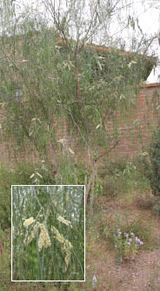
Acacia willardiana, palo blanco.
Acacia willardiana
palo blanco

With delicate, papery white bark, weeping branches, fine leaves and airy form, this small acacia provides an elegant touch to the landscape. Grows at a moderate rate, reaching 20 feet high and spreading to 15 feet wide. Its open form allows planting of sun-loving perennials below it. Accepts heat, even reflected heat of south-facing walls. Native to subtropical Sonora, Mexico.
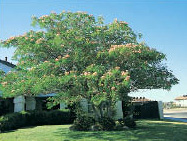
Albizia julibrissin, silk tree.
Albizia julibrissin
silk tree, mimosa tree
A deciduous tree that grows rapidly from 25 to 35 feet high and as wide. Develops a wide canopy with graceful, light green, feathery foliage. Best to stake young trees to develop form. Produces an abundance of rich pink, silky flowers in summer and sporadically at other times of the year. As flowers and pods drop, they create litter. A nice tree to view from above. Occasional deep watering is essential, otherwise, the tree is typically short-lived. Native to Asia.
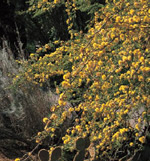
Acacia farnesiana, sweet acacia.
Arecastrum romanzoffianum
queen palm

(Syagrus romanzoffianum). Grows with a straight trunk 25 to 40 feet high with graceful, arching, feathery leaves. It responds to regular moisture and fertilizer during warm periods, but encouraging too-rapid growth can cause fronds to break. Locate in areas protected from strong winds. Protect young trees when temperatures drop below 30°F. Water deeply when sustained high temperatures reach 110°F to 120°F. A clean plant to have around pools. Native to Brazil.
Bauhinia species
Orchid Tree
Depending on the species, Bauhinia are native to the Chihuahuan Desert or to Asia. The Asian species are very frost tender, but the Chihuahuan natives are rough, and tough, and can take heat and cold. Bauhinia leaves are butterfly-shaped, but you’ll want to grow them for their gorgeous, orchidlike flowers.
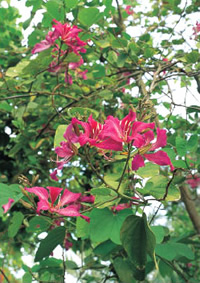
Bauhinia blakeana, Hong Kong orchid tree.
Bauhinia blakeana
hong kong orchid tree


Grows at a moderate rate from 15 to 20 feet high and wide. Abundant maroon to pink flowers bloom from December to April, and are quite dramatic in size and color. Deep water at drip line of tree about once each week in summer. Plant in well-drained soil. Native to China.
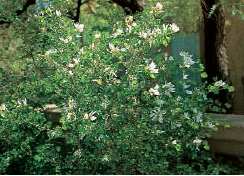
Bauhinia lunarioides, white orchid tree.
Bauhinia lunarioides
white orchid tree


(B. congesta). Another common name for this plant is Chihuahuan orchid shrub. It can be pruned into a small tree but usually is more shrublike, growing slowly to 15 feet high. Produces large clusters of fragrant, white or pink flowers in spring. Water deeply every three weeks during summer. Native to Chihuahuan Desert.
Bauhinia purpurea
purple orchid tree


Grows at a moderate rate to 30 feet high with umbrella-shaped canopy and gray-green leaves. Water deeply about once every week during summer. Native to India.
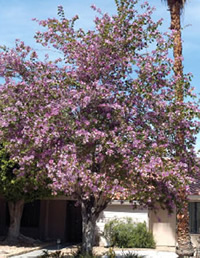 Bauhinia variegata, purple orchid tree.
Bauhinia variegata, purple orchid tree. Bauhinia variegata
purple orchid tree


Like Bauhinia purpurea, also called the purple orchid tree. It forms a dense, medium green crown at a moderate to rapid rate up to 25 feet high with an equal spread. Profuse magenta to purple flowers cover the branches in late winter. White-flowered forms are available. Mature trees can be seen throughout the Coachella Valley. Native to India and China.
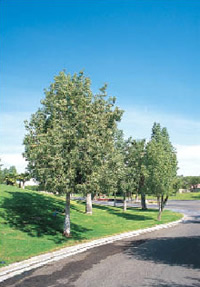
Brachychiton populneus, bottle tree.
Brachychiton populneus
bottle tree


Adapted to hot, dry and windy conditions. Evergreen, shiny, dark green leaves cover a pyramidal form that grows at a moderate rate from 30 to 50 feet high, spreading to 20 feet wide. Water at the tree’s drip line to encourage a deep, wide-spreading root system. Prune in winter to remove dead wood and control wayward branches. Leaf drop occurs in early spring as new leaves crowd out the old ones. Seed pods drop in late summer. Acidify soil to avoid chlorosis. Native to Australia.
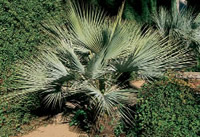
Brahea armata, Mexican blue palm.
Brahea armata
mexican blue palm

(Erythea armata). Slowly grows from 20 to 30 feet high, spreading only 10 feet wide, making it well-suited to small gardens. Icy blue fan-shaped fronds are an attractive feature. Use as an accent or blend with other silvery-leaved plants. Low litter plant, good near pools. Mature plants feature creamy flower clusters 6 to 10 feet long in summer. Native to Baja California.
Brahea edulis
guadalupe island palm

Featuring light green fan-shaped fronds, this fan palm grows slowly to 30 feet high, and spreads to about 10 feet at maturity. An ideal palm accent in small areas or around pools—it can take extreme heat and reflected light. Provide monthly deep waterings in summer heat. Native to Guadalupe Islands in Baja California.
Butia capitata
pindo palm

(Cocos australis). Accepts frost and extreme heat and sun—hardships of every kind. Grows slowly 10 to 20 feet high with an equal spread. Gray-green, feathery leaves are long and graceful. Uniquely rugged trunk shows off the former leaf bases, helping making this palm an ideal accent plant. Apply fertilizer to the soil if leaves yellow. Native to Brazil, Uruguay and Argentina.
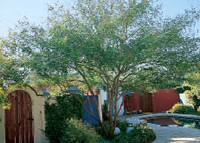
Caesalpinia cacalaco, cascalote.
Caesalpinia cacalaco
cascalote

An attractive, vase-shaped small tree, growing at a moderate rate to 15 feet high and almost as wide. Spikes of clear yellow flowers bloom at the branch tips late winter into early spring. Flowers can be damaged by late frosts. Avoid by planting in a protected location. Luxuriant foliage is armed with rose-sized thorns, so place away from pedestrian traffic. Plant in well-drained soil. Prune after the flowering season ends to control ungainly growth. Native to Vera Cruz, Mexico.
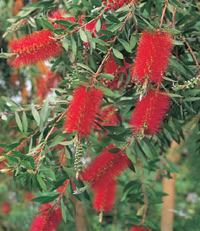
Callistemon viminalis, weeping bottlebrush.
Callistemon viminalis
weeping bottlebrush


An exceptional small tree that grows at a moderate rate from 20 to 30 feet high with a 15-foot spread. This freely branching evergreen has pendulous branches that become covered with magnificent, red, bottlebrush flowers midspring and summer. Attracts butterflies and hummingbirds. Do not plant in lawns—the roots do not like to be that moist. Also avoid windy locations. Native to Australia.
Callistemon citrinus is similar but has a less weeping form.
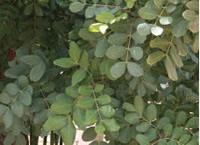
Ceratonia siliqua, carob.
Ceratonia siliqua
carob, st. john’s bread
This is a large, wide-spreading evergreen tree growing from 20 to 40 feet high and as wide. Moderate rate of growth. Carob’s round-headed form is densely branched and provides deep, cooling, welcoming shade. Compound leaves are a lush, shiny deep green. Female plants develop long, brown seed pods that can be messy. Male plants do not produce pods. Water deeply and infrequently to encourage deep rooting. Young trees need cold protection below 25°F. Native to the Mediterranean.
Cercidium species were recently
reclassified as Parkinsonia.
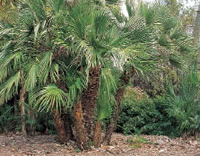
Chamaerops humilis, Mediterranean fan palm.
Chamaerops humilis
mediterranean fan palm

This is a slow-growing, multitrunked fan palm. Dwarfish in habit, it’s a fine palm for a small yard. Attains height of 10 to 12 feet at maturity. Faster growth with regular water and fertilizer during warm season. Leaves are small and abundant, the petioles armed with sharp spines. Plants may sucker freely, spreading to form a dense clump. A handsome tub plant or a featured plant near pools. Native to the Mediterranean and north Africa.
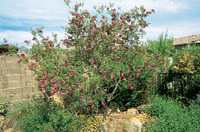
Chilopsis linearis, desert willow.
Chilopsis linearis
desert willow

This light, airy, 25- to 30-foot deciduous tree is perfect for locations where you need summer shade but want winter sun, such as on the south side of the house. Graceful, light-green leaves provide a splendid backdrop to clusters of large, orchid-like flowers that come in a wide variety of pinks, reds and purples. Many horticultural varieties of this lovely tree are now available, including some which flower spring and summer. Do any heavy pruning during the deciduous period—December into February. Prune to control growth, create new flowering wood and to display the handsome, smooth gray trunks. Native to Sonoran and Chihuahuan desert arroyos, it does best in soil with good drainage.
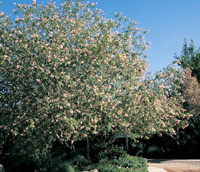
Chitalpa X tashkentensis, chitalpa.
Chitalpa X tashkentensis
chitalpa

This tree is a hybrid from Russia that is a cross of two genera, Chilopsis linearis and Catalpa bignonioides. Chitalpa combines some of the best characteristics of both plants. It is more evergreen and has larger, more vivid, white or pink flower clusters compared to its parents. Mature size of 20 to 30 feet high and as wide works well in most small gardens. Accepts partial shade. Availability at nurseries may be limited, but worth the search.
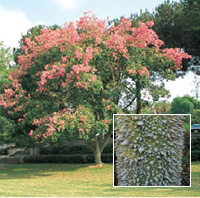
Chorisia speciosa, silk floss tree.
Chorisia speciosa
silk floss tree, kapok

Also called the drunkard’s tree, because the mature trees look like a giant, lime green Chianti bottle topped with spreading boughs. Trunk has distinctive thorns. In fall, profuse numbers of large, rose to wine-colored flowers appear, followed by seed pods filled with white cottony kapok, once used to fill life vests. Trees can reach 30 to 50 feet high and spread 25 to 40 feet, so they’re not a good choice for a small garden. Occasionally deciduous prior to bloom period. Avoid windy locations. Water deeply. Native to Brazil and Argentina.
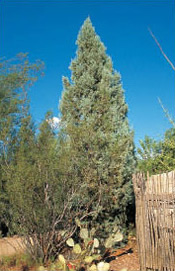
Cupressus arizonica, Arizona cypress.
Cupressus arizonica
arizona cypress
This is a superior, medium-sized evergreen for use as a windbreak or tall screen in low-maintenance situations. Grows at a moderate rate from 30 to 40 feet high and 30 feet wide with a pyramidal form. Gray-green, scalelike foliage varies from plant to plant. Branches have a distinct whipcord texture. Thrives in low-rainfall areas when established. Resistant to cypress canker.
‘Gareei’ is a grafted selection, which means plants will consistently have rich, silvery, blue-green foliage. ‘Blue Ice’ features silvery-blue foliage. ‘Compacta’ has a more compact growth form.
Note: Cupressus arizonica is often called rough-barked Arizona cypress, and C. glabra as smooth-barked Arizona cypress. Rough-barked Arizona cypress is known to perform better in the Coachella Valley.
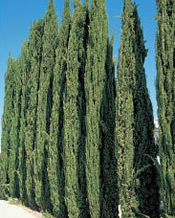
Cupressus sempervirens, Italian cypress.
Cupressus sempervirens
italian cypress

This tall, vertical accent tree is often used in formal landscapes. It is propagated by cuttings rather than grown from seed to reproduce its desired qualities. The distinctive, narrow and dense columnar form reaches 20 to 60 feet high.
Red spider mites can appear in summer and kill drought-stressed trees. Water deeply every three weeks to avoid this problem. Treat mites when they appear. Native to the Mediterranean.
‘Glauca’ has attractive, bluish green, juniperlike foliage. ‘Stricta’ is similar in form and size with dark green foliage.
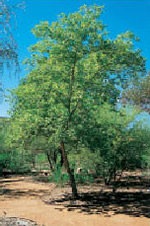
Dalbergia sissoo, Indian rosewood.
Dalbergia sissoo
indian rosewood

This is a moderately fast growing shade tree that generally reaches 40 feet high and 30 wide with a rounded crown. Evergreen to cold-deciduous with below-freezing temperatures, but recovers quickly in spring. Bright glossy, lush green leaves make this a pleasant shade tree. Wide spreading roots are useful to stabilize erosion-prone banks and slopes. This is not commercial rosewood, but is used in its native India as a timber tree.
Dalea spinosa
desert smoke tree

(Recently reclassified as Psorothamnus spinosus.) This native of the Mojave and Sonoran Desert is often overlooked when planning a landscape, and that is a shame. Native to the Coachella Valley region, it survives wonderfully without much care other than shaping young trees into tree form (if desired). Grows better with some extra water; its natural habitat is along desert washes. Does best in sandy to rocky soils.
This small tree is well-suited to today’s smaller lots. Unlike many other desert trees, it fills in densely to provide an effective screen. Grows at a slow to moderate rate from 15 feet high and as wide. In late spring the silvery gray, smoky-looking branches are virtually obscured by the striking, fragrant, deep purple-blue blooms.
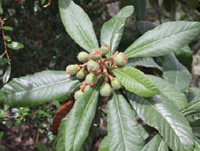
Eriobotrya japonica, loquat.
Eriobotrya japonica
loquat, japanese plum

Lush, tropical-looking fruit tree that grows at a moderate rate to 15 feet high and as wide with a rounded crown. Plant in a location protected from high winds, and where it will receive afternoon shade. Woolly, cream-colored flowers in fall produce delicious, pear-shaped clusters of fruit in spring. Trees will recover from hard freezes, but fruit are damaged at about 28°F. For highest quality fruit, select a named grafted cultivar such as ‘Champagne’, or ‘Thales’. Native to Japan and China.
Eucalyptus species
Eucalyptus
All of the readily available species of eucalyptus are evergreen and grow rapidly when young. The trees are evergreen, but individual leaves are constantly being shed with new leaves replacing them. This makes them poor choices near pools. Twigs and bark of some species also create litter. Most species produce flowers that are generally inconspicuous cream-colored puffs followed by small seed pods.
Natives of Australia, many species of eucalyptus have been imported to the West, where they are used in home and commercial landscapes. Initially, they served to drain swampy areas, and planted as windbreaks to protect orchards and homesites. They continue these utilitarian roles today. A serious pest, eucalyptus thrips, can kill trees if not controlled. Treat for thrips when you first discover them.
Selecting eucalyptus for a home landscape requires careful planning, because many species grow to 60 feet or even higher—much too large for most residences. Smaller species are better suited to the size and scale of most home lots. Be particularly careful when selecting trees if power lines are part of your landscape. Encourage deep, wide-spreading roots with deep and wide watering, ideally with drip irrigation.
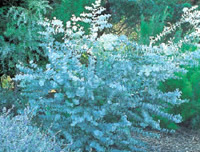
Eucalyptus cinerea, silver dollar tree.
Eucalyptus cinerea
silver dollar tree

Medium-sized tree from 20 to 50 feet high. It has a tendency to form multiple trunks, which make it attractive when viewed as a silhouette. Gray-green, rounded leaves grow as opposites along the stems. Juvenile leaves are excellent for cut foliage in flower arrangements. Tolerates wind, and can be planted 10 to 15 feet apart as a windbreak. Accepts lawn conditions.
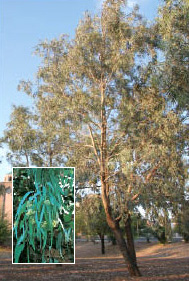
Eucalyptus microtheca, coolibah.
Eucalyptus microtheca
coolibah


Graceful tree from 20 to 40 feet high, but tends to take on a leaning posture unless staked when young. Best results when trained as a single trunk. Trunks of older trees eventually become brown and corky. Can be used as a windbreak, with less fragile branches than other species.
Eucalyptus papuana
ghost gum


Grow this stately eucalyptus for its notable, smooth, snowy white trunk. Grows at a moderate rate, reaching from 20 to 60 feet high and 15 to 30 feet wide, often with multiple trunks. Leaves are leathery, gray to medium green, and pendulous, making it a good specimen tree for the landscape.
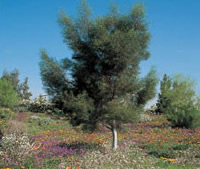
Eucalyptus spathulata, swamp malee.
Eucalyptus spathulata
swamp malee

Evergreen, compact and handsome, with multiple trunks. Smooth, reddish to tan, peeling bark adds a sculptural effect. Grows at a moderate rate 15 to 30 feet high with an equal spread. Graceful, ribbonlike leaves 2 to 3 inches long are grayish green. Makes an excellent screen or windbreak. Its size, color and texture allows swamp malee to blend better with desert vegetation than most other eucalyptus. Tolerates salty, poor soil, and can be planted near lawns.
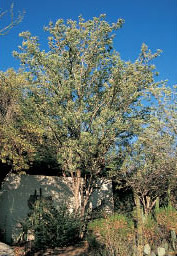
Eysenhardtia orthocarpa, kidneywood.
Eysenhardtia orthocarpa
kidneywood
(E. polystachya). A small, thornless tree to 15 feet high, sometimes more, spreading to 10 feet wide. It tends to be multitrunked, and can be kept as a shrub. Grows at a moderate rate with an open and airy form. Light green, compound leaves allow for excellent filtered light for plants such as perennials or small shrubs underneath. Accepts some shade. Fragrant white flower spikes are pollinated by butterflies, and bloom through summer. Native to Arizona.
Fraxinus uhdei ‘Majestic Beauty’
majestic beauty, evergreen ash

Vigorous growth, reaching 50 to 60 feet high with 50-foot spread. Strong branching habit. Exceptionally large, compound, glossy, dark green leaves add splendor to this medium-sized, round-headed tree. Cold-deciduous below 30°F. More uniform growth than other ashes and more cold tolerant, but leaves may burn if subjected to hot winds. Deep irrigation helps reduce surface rooting. Parent stock native to streamsides in Mexico.
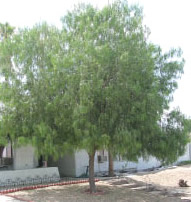
Geijera parviflora, Australian willow.
Geijera parviflora
australian willow


This evergreen, graceful, fine-textured tree grows at a moderate rate, reaching 15 to 25 feet high and 15 to 20 feet wide. Rounded to pyramidal in form, it remains small enough for patios. Plant it for the weeping willow appearance created by the medium green, strap-shaped leaves. Uniform growth at a moderate rate can be accelerated with additional water. Good soil drainage is essential. Native to Australia.
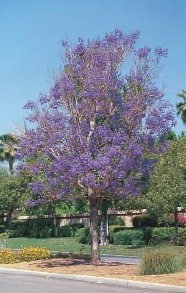
Jacaranda mimosifolia, jacaranda.
Jacaranda mimosifolia
jacaranda


(J. acutifolia). This is a large, round-headed, semievergreen tree that grows at a moderate to rapid rate 30 to 50 feet high and 15 to 30 feet wide. Best for parks, commercial use or large residences due to its size. Lacy, fernlike, green leaves and large clusters of attractive, lavender-blue flowers bloom profusely May and June, producing an appealing tropical effect. As flowers drop, they produce a fair amount of litter, so avoid locating trees near swimming pools. Plant in soil with good drainage. Water deeply to reduce development of surface roots but do not overwater. Water weekly in growing season, but only once or twice during dormant winter period. Suckers if pruned too drastically. Native to Brazil.
Koelreuteria bipinnata
chinese flame tree

(K. integrifolia). Grown in part for its small, yellow, summer flowers. These become inflated papery pods that resemble miniature Chinese lanterns. As the season progresses, the pods change from a creamy white to orange-red and brown. Makes a nice shade tree from 20 to 35 feet high with an equal spread. Trees develop sturdy trunks that are often irregular, but light pruning of young trees can direct growth. Plant in well-drained soil. Deciduous, with variable fall color. Native to China.
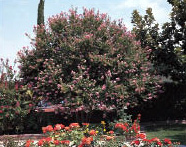
Lagerstroemia indica, crape myrtle.
Lagerstroemia indica
crape myrtle

Vigorous deciduous tree or shrub that offers year-round interest. Can be trained to become a quality tree to 25 feet, admired for its striking clusters of flowers that bloom summer into fall. Foliage turns bright shades of orange, yellow or red in fall. After leaves drop, the satiny, pale, sculptural bark adds close-up interest. Avoid planting in lawn areas, which can cause plants to develop mildew problems, as will excessive humidity. Can be grown in containers. Many hybrids and cultivars are available in a range of flower colors, including white, pink, red, magenta, lavender and purple. Native to China.
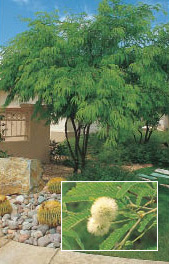
Lysiloma watsonii var. thornberi, feather tree.
Lysiloma watsonii var. thornberi
feather tree

(L. microphylla var. thornberi). Finely divided, fernlike foliage provides a lush, tropical effect. Creates dappled shade that can accommodate underplantings of perennials and small shrubs—highly effective in a mini-oasis setting. By the time plants are 6 to 10 years old, the multitrunk growth can reach 15 to 20 feet. It also can be grown as a shrub. After a spring show of creamy white, puffball flowers, seed pods are numerous enough to create litter in early summer, but are easy to remove. Avoid pruning large branches in summer. Plant in full sun in soil with good drainage. Overwatering during summer can create chlorotic conditions. Although it can freeze to the ground, it will regrow as a large shrub. Native to Sonora, Mexico.
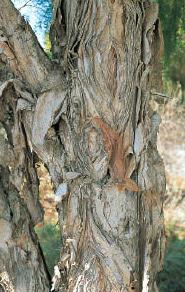
The distinctive bark of Melaleuca
quinquenervia, cajeput tree.
Melaleuca quinquenervia
cajeput tree

Slender, vertical, evergreen tree from 20 to 35 feet high, spreading 10 to 20 feet wide. Bark is white to light brown, thick, corky and peels off the trunk in sheets. Rich green foliage is graceful, thickly covering the branches. Thin branches as necessary as tree ages, but do not top. Stands up to strong winds. Slender spikes of creamy white flowers adorn branches in summer. Water deeply to encourage deep rooting. Accepts some shade. Native to Australia.
A related species, Melaleuca alternifolia, is the source of “tea tree oil.”
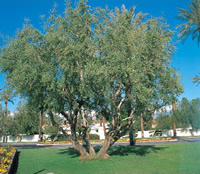
Olea europaea, olive.
Olea europaea
fruitless olive

Olive is a time-honored, quality, evergreen tree with an informal, picturesque growth habit. Grows at slow to moderate rate 20 to 30 feet high and as wide, as a standard form, or with multiple trunks. With time, trunks become gnarled, adding to the tree’s character. Distinctive, narrow, gray-green leaves reach up to 3 inches long. Olive fruit can become a problem, littering and staining pavement. Pollen production also affects many people with allergies. ‘Swan Hill’ is a fruitless selection.
Accepts low water applications, but additional moisture produces a more handsome tree. Avoid heavy pruning, especially late spring through summer, which can allow sun to damage trunk. Keep lower trunks shaded. If trees are pruned up, they will sucker profusely to shade themselves. (Pull off suckers rather than pruning them.) Olives accept almost any soil, endure heat, cold and wind. Native to the Mediterranean.
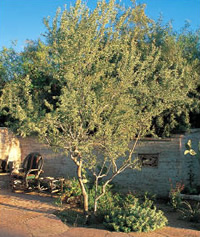
Olneya tesota, desert ironwood.
Olneya tesota
desert ironwood
Just as olive trees create a focal point in the landscape, desert ironwood possesses a similar presence, with gray-green foliage and gray trunks with real character. Lavender, pealike flowers give trees an otherworldly glow in April and May, attracting bees in abundance. Slow growing from 25 to 30 feet high and as wide. It requires some patience but the reward of a quality, long-lived tree is worth the wait. Sharp thorns on branches can be a safety hazard near walkways as well as when pruning trees. Requires well-drained soil. Native to the Sonoran Desert.
Parkinsonia species
Palo Verde
(Cercidium species). These American desert natives provide a definite personality to the landscape. They are easily recognized due to their blue-green to green bark, naturally occurring multiple trunks and graceful elegance. Most are wide spreading from 25 to 35 feet with a similar height, which varies according to the species, moisture, and soil type. Masses of yellow flowers cover the trees in April and early May. All tolerate extremes of heat, sun, and soils, although they do best well-drained soils.
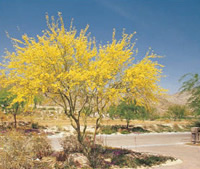
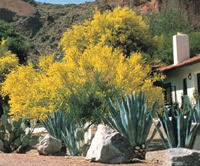
Parkinsonia floridum, blue palo verde.
Parkinsonia floridum
blue palo verde

Blue palo verde is one of the most colorful desert trees. The strong, multitrunk form grows rapidly, developing a spreading canopy to 35 feet high and 30 feet wide, producing filtered shade. Luxuriant, golden yellow flowers appear in profusion March into April. Bark is a striking bluish green. With age, main trunk darkens to brown. Encourage its natural, angular form and avoid pruning heavily at any one time, which can interrupt growth patterns. Native to the Sonoran Desert.
Parkinsonia microphylla
little leaf palo verde, foothills palo verde

Bark is lime-green. It grows slowly to 20 feet high, with a smaller, stiffer appearance than Parkinsonia floridum. Tree is semideciduous—leaflets drop in cold or drought. Yellow flowers appear April into May. Slow growth rate can be accelerated by supplying additional moisture. Twiggy growth and low canopy provide shelter for wildlife. Ideal background tree or for screening. After young trees are established, electively thin branches to show off interesting trunk structure. Makes an excellent small patio tree with character. Native to Arizona and Baja California.
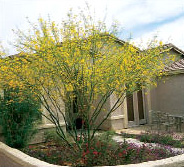
Parkinsonia hybrid 'Desert Museum', Desert Museum palo verde.
Parkinsonia hybrid ‘Desert Museum’
desert museum palo verde

This superior Parkinsonia is a result of hybridizing work involving P. floridum, P microphyllum and P. aculeata, Mexican palo verde. This work was performed at the Arizona-Sonora Desert Museum in Tucson. Growth pattern of thornless ascending branches produces a sturdy structure and strong vertical form. Mature height is 25 feet to 30 feet with 20-foot spread. Flowers are rich yellow. The main bloom occurs during spring, although it flowers sporadically during summer with supplemental irrigation. Plant in deep soil.
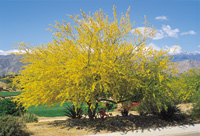
Parkinsonia praecox, palo brea.
Parkinsonia praecox
palo brea, sonoran palo verde
Grows slowly into a 15- to 25-foot tree. Vivid yellow flower clusters bloom in April into May. Palo brea has a more upright structure and thornier branches than other Parkinsonia species, with distinctive, sculptural, angular branches. Bark on trunks and branches remains green, even as tree ages. Occasional deep watering improves appearance. Native to southern Sonora, Mexico.
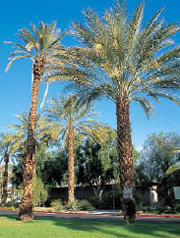
Phoenix dactilyfera, date palm.
Phoenix dactilyfera
date palm


These trees are large and picturesque, plus they produce tasty fruit, but they are not the right choice for a small garden or home. Plants grow slowly but when mature, they reach up to 60 feet high with a trunk 2 to 3 feet in diameter. Young trees need space, the fronds spreading to 25 feet across. Near the trunk, the bases of the feather-shaped leaves have stout thorns. Requires moderate watering throughout summer for trees to look their best. Be aware that fruit drop can be messy, especially around pools and patios. Native to northern Africa.
Pinus species
Pine
Pines can be grown successfully in the Coachella Valley, as long as adapted species are selected. Some pines can become quite large, so exercise caution when choosing trees for residential-scale landscapes. Pines evoke a feeling of the mountains and create a cooling mood, but it is challenging to blend them with other arid land plants.
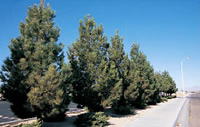
Pinus eldarica, Afghan pine.
Pinus eldarica
afghan pine, mondale pine

(P. brutia). Rapid pyramidal growth from 30 to 40 feet high and to 25 feet wide. Accepts heat, severe wind, cold and a variety of soils. In well drained soil, roots are better able to penetrate, allowing for deep rooting and more prolific growth. Use as an attractive, dense windscreen or featured landscape tree. Tolerates windy conditions. Native to Afghanistan.
Similar in appearance is P. halepensis, Aleppo pine. Native to the hills of Lebanon, Aleppo pine often suffers from spider mites, and generally does not tolerate Coachella Valley conditions long term as well as the Afghan pine.
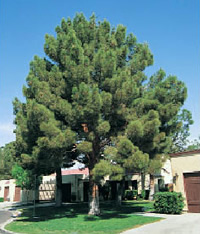
Pinus pinea, Italian stone pine.
Pinus pinea
italian stone pine


This pine is broadly conical when young, then becomes spreading and flat-topped (shaped like an umbrella) as it ages. Mature size is 25 to 40 feet high, spreading to 25 feet wide. Grows at a slow to moderate rate. Picturesque trunk and branch structure develop over time. Needles are bright green. This tree produces the edible pignolia nut. Native to southern Europe.
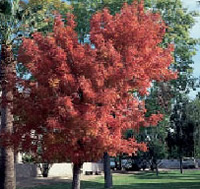
Pistacia chinensis, Chinese pistachio.
Pistacia chinensis
chinese pistachio

Moderate growing, long-lived tree from 30 to 40 feet high with a broad-spreading canopy that produces dense shade. Deciduous, with bright green, compound leaves that turn intense crimson colors in fall months. Accepts a wide variety of adverse conditions. Does best with periodic deep soaking of soil around the root zone. Native to China.
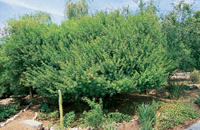
Pistacia lentiscus, evergreen pistachio.
Pistacia lentiscus
evergreen pistachio

A slow growing, wide-spreading, evergreen tree, reaching 15 to 20 feet high with a spread to 30 feet wide. The dense, attractive, bluish green foliage makes this a highly useful background tree or screen. Flowers are inconspicuous. Tolerates drought, heat and salty soils. Native to the Mediterranean.
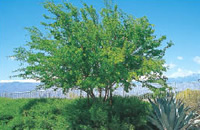
Pithecellobium flexicaule, Texas ebony.
Pithecellobium flexicaule
texas ebony

(Newly reclassified as Ebanopsis ebano.) The dense, dark green leaves and spiny twigs of Texas ebony can develop into a great security barrier. Even without a utilitarian use in mind, its picturesque form makes this a desirable tree for a small garden. Avoid planting near walkways or other pedestrian traffic areas due to its small, sharp thorns. A slow grower, the mature height is 20 to 30 feet with a spread of 15 to 20 feet, but this will take many years. Fragrant, cream-colored flowers add color in late spring, they are followed by large, decorative, woody, brown seed pods. Grows in almost any well-drained soil. Native to Texas and New Mexico.
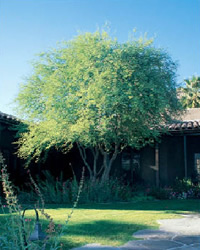
Pithecellobium mexicanum, Mexican ebony.
Pithecellobium mexicanum
mexican ebony
(Newly reclassified as Havardia mexicana.) Lovely, smooth, gray bark and a naturally rounded form make this a great addition to the landscape. A moderately fast grower, reaching around 30 feet high and as wide but usually less in a low desert climate. Its fine-textured, gray-green foliage is cold deciduous. Creamy yellow puffball flowers appear in spring, followed by ornate woody brown pods. Best when planted in well drained soil. Native to Sonora and Baja California.
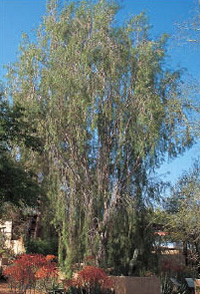
Pittosporum phillyraeoides, willow pittosporum.
Pittosporum phillyraeoides
willow pittosporum


This is a handsome, evergreen tree, reaching 15 to 20 feet high, spreading 10 to 15 feet wide. Moderate growth rate. Light, gray-green, ribbony leaves to 4 inches long “weep” downward. Makes a fine vertical accent. Stake young trees to provide a straight start. Small, fragrant, yellow flowers bloom late winter to early spring. Native to Australia.
Prosopis species
Mesquite
Mesquites offer quite a lot to Coachella Valley gardeners. Their size, form, color and texture are in tune with the desert, helping provide a suitable sense of place. In fact, native mesquites are excellent for residential landscapes. Their quick rate of growth, cooling, sheltering shade and low maintenance make mesquites natural choices. In recent years, the number of selections available to home gardeners has increased. Each has special merit.
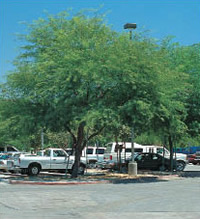
Prosopis chilensis, Chilean mesquite.
Prosopis chilensis
chilean mesquite
This mesquite is admired for its ability to provide fast shade and screening. Young trees need staking and adequate ties to help support heavy top growth. Thin no more than 20 percent of interior growth at any one time to prevent sunburn damage. Do not plant within 15 feet of walls because roots tend to be shallow. Water deep and wide to encourage deep, extensive root system that will help trees stand up to strong winds. Moderate thorns. Avoid planting near pools because litter can be a problem throughout the year. Native to Chile.
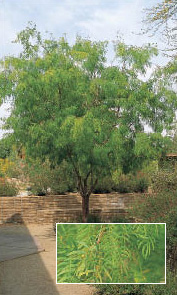
Prosopis glandulosa var. glandulosa, honey mesquite.
Prosopis glandulosa var. glandulosa
honey mesquite

Less rigid in growth form than other mesquites, honey mesquite has a graceful, slightly weeping form that closely resembles Schinus molle, California pepper. It grows at a moderate rate from 15 to 30 feet high with an equal spread. Young branches are thorny. Small, bright green leaves are deciduous (leaves drop in winter). Naturally deep-rooted. Native to Chihuahuan Desert, and as far north as Oklahoma.
Prosopis hybrid ‘Phoenix’
‘phoenix’ mesquite
A hybrid with a number of parents, this new cultivar grows quickly but not excessively so, reaching 30 feet high and as wide. Features the dense green foliage of Argentine mesquite, but without thorns, and with the deep-rooting characteristic of honey mesquite.
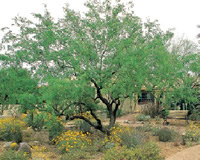
Prosopis velutina, velvet mesquite.
Prosopis velutina
velvet mesquite

This native mesquite grows to 30 feet high with an equal spread. Foliage is a velvety gray-green, and semideciduous. Seed pods are edible and were a staple food of natives. Young branches have small thorns that become less abundant with maturity. With age, trunks take on a gnarled and shaggy appearance, resulting in trees of great character. Young trees are slow growing and character is more shrublike. Additional water will increase size and growth rate. Native to southeastern Arizona into Texas.
Prunus caroliniana ‘Bright ‘n Tight’
cherry laurel

This is a specially selected strain of Carolina laurel cherry, with tight, compact growth 8 to 20 feet high. Glossy, deep green, evergreen leaves on an upright plant that can be either a small multi-trunked tree or large shrub. Small creamy white flowers in March are followed by blackish red berries that birds enjoy. Pick a location with afternoon shade in the Coachella Valley, and don’t plant in saline or alkaline soils. Hybrid of parents native to southern Appalachia.
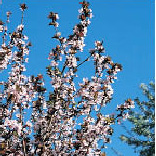
Prunus cerasifera 'Krauter Vesuvius', purple plum.
Prunus cerasifera ‘Krauter Vesuvius’
purple plum


Open, rounded, tree 10 to 15 feet high, with a rounded crown spreading to 10 feet wide. Admired for its striking, dark purple, almost black foliage. Deciduous. Pink flowers bloom in spring. May bear fruit in summer. Avoid planting in windy locations. Best where it will receive afternoon shade. Hybrid of parents native to the Mediterranean.
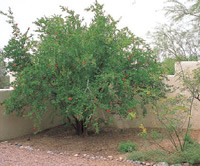
Punica granatum, pomegranate.
Punica granatum
pomegranate

This is a deciduous small tree or shrub 12 to 20 feet high and to 15 feet wide. Well-adapted to the Coachella Valley. Pomegranate has much to recommend it: bright green leaves, large, ruby flowers, healthy fruit, plus golden yellow fall foliage. With time, becomes a great hedge and security barrier plant. Prune when dormant in winter. High-water use in summer if fruit is the goal. Otherwise, supply moderate water. Does well in alkaline soils. Accepts some shade. Native to southern Asia.
Many cultivars are available: ‘Chico’, dwarf carnation-flowered pomegranate, grows to 8 feet high. ‘Legrellei’ grows 6 feet to 8 feet high, and has double creamy flowers with coral-red stripes. ‘Nana’, dwarf pomegranate, is more evergreen with dense growth to 3 feet high. It’s a dependable performer with orange-red, single flowers and small, dry, red fruit. ‘Wonderful’ grows to 10 feet high, has orange-red, 4-inch flowers and sweet fruit.
Quercus species
Oak
Oaks are not the trees that spring to mind when one thinks of a landscape for the desert, but these rough and tough trees will accept the heat, drought, winds and occasional cold. They take what the desert dishes out, and with a deep soak once a month in summer, provide the homeowner with a large, stately tree.
Quercus agrifolia
california coastal live oak

Large, round-headed, evergreen tree 30 to 50 feet high. Fire-resistant rough, dark brown bark on broadly spreading, picturesque branches that may spread wider than the tree is tall. Dark green, hollylike leaves. Best adapted to Palm Springs area near foothills and canyons. Native to coastal southern California.
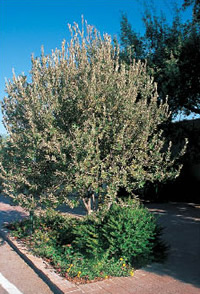
Quercus ilex, holly oak.
Quercus ilex
holly oak

Excellent, medium-sized evergreen tree from 20 to 30 feet high with equal spread. A multitude of small, medium green, finely toothed, hollylike leaves provide dense shade. Planted in a row, holly oak makes a good hedge. Planted singly, it is a refined and elegant specimen. Tolerates lawn planting. Native to the Mediterranean.
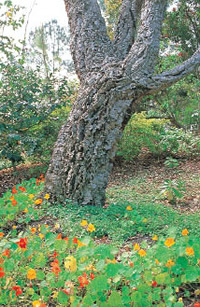
Quercus suber, cork oak.
Quercus suber
cork oak
An evergreen tree with broad, rounded crown that produces deep shade. Moderate growth from 25 to 40 feet high with a short trunk. Leaves are lustrous, dark green above, grayish beneath. Pale, thick and deeply furrowed, corky bark adds close-up interest. In certain regions of the world, it is harvested as cork for commercial use. Native to the Mediterranean.
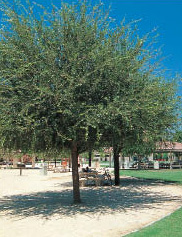
Quercus virginiana, southern live oak.
Quercus virginiana
southern live oak

A quality evergreen tree that grows 50 to 60 feet high with an equal spread. Best performance in well-drained soil. Thrives on deep irrigation. ‘Heritage’ is an improved selection, proven to be adapted to desert heat and wind. Grows rapidly, producing impressive branches and trunk. Native to southeastern U.S.
Q. fusiformis, escarpment live oak, is also recommended. It is very similar to southern live oak.
Rhapis excelsa
slender lady palm


An exceptionally decorative and rare palm, lady palm forms dense clumps of many individual stems 6 to 8 feet high. Fronds are palmate. Best growth in bright, indirect light and nutrient-rich soil; it responds to applications of fertilizer. Good specimen plant in filtered shade near a pool, or in tubs or planters indoors. Native to Japan.
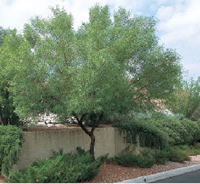
Rhus lancea, African sumac.
Rhus lancea
african sumac

A dense, wide-spreading, evergreen tree with a slight, weeping or drooping growth habit. Mature trees 20 to 25 feet high may spread to 40 feet or more. A workable tree for a small garden but it produces a great deal of litter throughout the year. Reddish stems and shiny, medium green leaves are borne in three slender leaflets. Female plants produce tan to reddish berries in clusters. Avoid heavy pruning at a single session. Some people are allergic to all parts of the tree. Native to South Africa.
Schinus molle
california pepper


A fast-growing, medium-sized evergreen tree from 30 to 40 feet high. It has a round-headed form with graceful, weeping branches and feathery, bright green foliage. Small, rose-colored berries hang in clusters on branches in fall. Low to moderate water use, depending on soil type. Branches of older trees are prone to breakage in strong winds. Originally native to Peruvian Andes, trees were brought to the early California missions by Spanish monks.
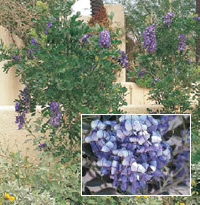
Sophora secundiflora, Texas mountain laurel.
Sophora secundiflora
texas mountain laurel


Small tree or large shrub from 10 to 15 feet high and as wide, with glossy green, evergreen leaves. Clusters of purple, wisteria-like flowers bloom in spring and perfume the air with a delightful fragrance. Attractive, grayish white seed pods contain red seeds that are poisonous. Plants have overall great tolerance for desert climates. Accepts almost any well-drained soil. Restrained, compact growth requires minimal pruning. Native to Texas.
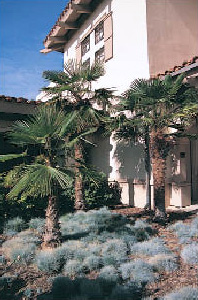
Trachycarpus fortunii, windmill palm.
Trachycarpus fortunii
windmill palm


A superior, middle-sized palm with fan-shaped leaves that radiate like a windmill from its compact crown. The trunk is naturally shaggy with hairy black fibers and old leaf bases. Do not remove these as it harms the plant. Grows slowly 15 to 25 feet high, spreading 6 to 8 feet wide. Trunks can be 1 foot in diameter. This palm does best with afternoon shade, and does not tolerate reflected sun such as near a pool. Give regular applications of water and fertilizer during the warm months. Due to its smaller stature, can be planted in atriums, entryways and even in large containers. Native to China.
Ulmus parvifolia
evergreen elm,
little leaf elm

This broad, umbrella-shaped tree quickly reaches to 35 feet high and as wide. Plant is semi-evergreen, dropping its small, dark green leaves and regrowing them over several months from winter to early spring. Bark is attractive mottled tan and brown. Water deeply to avoid shallow roots, which can become unsightly (even hazardous) on the soil surface. Native to China.
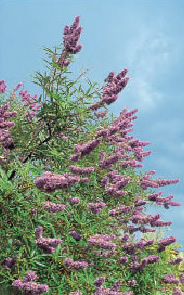
Vitex agnus-castus, chaste tree.
Vitex agnus-castus
chaste tree

Long-lived and slow growing, this small deciduous tree can take the heat. Narrow leaves produce a spicy fragrance when crunched underfoot after they drop from branches in fall. Grow as a large shrub or small tree 15 to 25 feet high and as wide. Many cultivars are available. Depending on the selection, lavender, blue or white spikes of flowers bloom in summer. They attract butterflies. Cold hardiness also depends on cultivar seed source. Native to southern Europe.
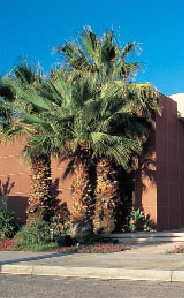
Washingtonia filifera, California fan palm.
Washingtonia filifera
california fan palm

This is the only palm native to California, growing naturally in Palm Canyon and other canyons in the Coachella Valley. Trunks can become massive, often reaching 3-1/2 feet in diameter. Large fronds are borne on long leaf stems; the leaves are fringed with coarse white hairs. Accepts the desert heat but younger plants prefer some shade. Slower growing than Washingtonia robusta (see below), reaching a mature height of 35 to 40 feet. Provide occasional deep watering.
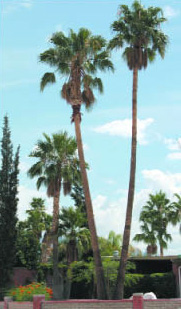
Washingtonia robusta, Mexican fan palm.
Washingtonia robusta
mexican fan palm

(Washingtonia gracilis). This native of Baja California is similar to California fan palm, but its trunk is more slender, usually 15 to 18 inches in diameter. It has a faster growth rate compared to W. filifera. Fronds are smaller with shorter stems and fewer filaments. Mexican fan palm becomes a skyline tree, reaching 50 to 75 feet high. Group only with own species in clumps of plants that are of staggered heights. Provide occasional deep watering.